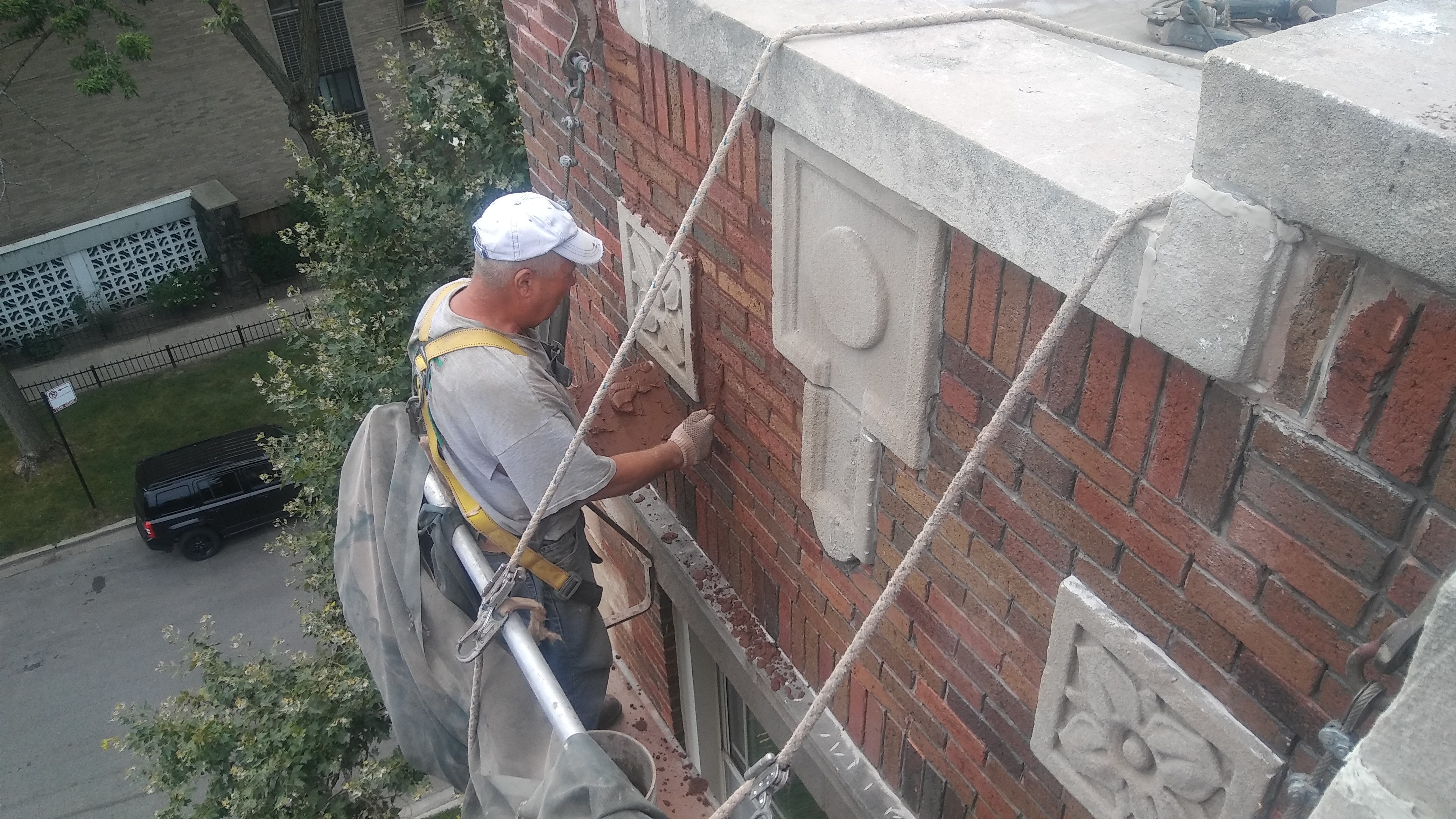Chicago’s brick homes and buildings are a testament to the city’s architectural legacy—but decades of lake-effect winters, driving rain, and temperature swings can erode mortar joints, leading to leaks, drafts, and structural decay. Chicago tuckpointing isn’t just cosmetic; it’s a vital necessity that preserves your property’s safety and value.
At Casey Tuckpointing, we’ve served Chicago homeowners for many years, restoring brickwork in neighborhoods from Lincoln Park to Pilsen. In this guide, we’ll help you identify a contractor who respects Chicago’s unique challenges and delivers lasting results.

Why Chicago Homes Need Specialized Tuckpointing
- Freeze-Thaw Cycles: Moisture trapped in cracked mortar expands when frozen, accelerating damage to bricks.
- Historic Preservation: Many Chicago homes (pre-1940s) require lime-based mortar to avoid damaging delicate, century-old bricks.
- Local Codes: Historic districts like Old Town or Pullman often have strict permitting rules. A qualified contractor will navigate these requirements.
5 Red Flags to Avoid When Hiring a Tuckpointing Contractor
1. “One Mortar Fits All”
Why It’s a Red Flag:
Mortar isn’t universal—especially in Chicago tuckpointing, where homes span centuries of architectural styles. Historic brickwork (common in neighborhoods like Old Town or Pullman) often requires lime-based mortar, which is flexible and breathable. Modern cement-based mortar, while durable, traps moisture in vintage bricks, leading to spalling (cracking or flaking) and irreversible damage.
What to Do Instead:
- Demand a contractor who tests your existing mortar to determine its composition (e.g., lime, cement, or a mix).
- Ask how they’ll match the mortar’s color, texture, and strength to preserve your home’s structural and aesthetic integrity.
- For historic homes, insist on lime mortar or a compatible modern alternative.
Key Takeaway:
→ A skilled contractor tailors materials to your home’s era and brick type.
2. No Chicago-Specific Portfolio
Why It’s a Red Flag:
Tuckpointing a Gold Coast brownstone isn’t the same as repairing a modern Lincoln Park condo. Chicago’s diverse architecture—from vintage two-flats to courtyard buildings—requires knowledge of:
- Local building codes: Permitting rules vary by neighborhood (e.g., historic districts vs. new construction).
- Weather challenges: Techniques must account for lake-effect moisture and freeze-thaw cycles.
- Material sourcing: Brick and mortar types differ across Chicago’s architectural eras.
What to Do Instead:
- Review the contractor’s portfolio for projects in neighborhoods like Wicker Park, Pilsen, or Hyde Park.
- Ask for references from Chicago homeowners, specifically those with brick homes similar to yours.
Key Takeaway:
→ Local experience ensures compliance with Chicago’s codes and climate demands.
3. Vague Quotes or Timelines
Why It’s a Red Flag:
Ambiguity in quotes or timelines often leads to hidden fees, delays, and frustration. For example:
- A “ballpark estimate” that excludes cleanup, scaffolding, or permit fees.
- Promises like “done in a week” without accounting for weather delays (common in Chicago’s unpredictable climate).
What to Do Instead:
- Request a written, itemized quote that breaks down labor, materials, permits, and cleanup.
- Ensure timelines include buffer days for rain or snow.
- Ask how they’ll communicate updates (e.g., daily check-ins via email or app).
Key Takeaway:
→ Transparency in pricing and scheduling prevents surprises.
4. No Weatherproofing Plan
Why It’s a Red Flag:
Chicago’s weather is brutal on mortar. Without proper weatherproofing:
- Rain and snow seep into joints, accelerating freeze-thaw damage.
- High winds drive moisture deeper into brickwork.
- Summer humidity weakens improperly sealed mortar.
What to Do Instead:
- Ask how the contractor will seal and protect joints after repairs (e.g., using breathable sealants).
- Ensure they plan for seasonal challenges (e.g., avoiding tuckpointing in freezing temperatures).
Key Takeaway:
→ Weatherproofing isn’t optional—it’s critical for Chicago homes.
5. Pressure to Pay Upfront
Why It’s a Red Flag:
Contractors demanding full payment upfront may lack the cash flow to complete your project—or worse, disappear mid-job. This is especially risky for large tuckpointing projects, which can cost thousands.
What to Do Instead:
- Agree to a phased payment schedule (e.g., 30% deposit, 50% midway, 20% upon completion).
- Avoid contractors who refuse to put payment terms in writing.
Key Takeaway:
→ Reputable contractors align payments with project milestones.

Key Questions to Ask a Chicago Tuckpointing Pro
- “Do you use lime mortar or cement-based mortar for historic homes?”
→ Why it matters: Lime mortar is breathable and flexible, critical for preserving vintage brick. Cement traps moisture, causing irreversible damage. - “Can you share examples of Chicago projects you’ve completed?”
→ Local experience ensures familiarity with neighborhood codes and architectural styles. - “How do you protect my property during repairs?”
→ Look for answers like scaffolding, dust containment, and post-job cleanup.
How to Maintain Your Tuckpointing Investment
Even the highest-quality tuckpointing requires occasional upkeep to maximize its lifespan in Chicago’s demanding climate. After your project is complete:
- Schedule Annual Inspections: Have a professional check for hairline cracks or minor erosion, especially after harsh winters. Early detection prevents costly repairs.
- Clean Gutters & Downspouts: Ensure proper drainage to direct water away from brick walls—standing water accelerates mortar decay.
- Avoid Pressure Washing: High-pressure water can strip mortar and damage historic brick. Opt for gentle cleaning methods instead.
Why Chicago Trusts Casey Tuckpointing
While researching contractors, prioritize those who:
- Respect Historic Materials: We analyze your mortar’s composition and use period-appropriate techniques to protect your brickwork.
- Understand Local Challenges: From Wicker Park’s vintage facades to Bronzeville’s historic homes, we tailor solutions to Chicago’s climate and codes.
- Prioritize Transparency: We provide detailed timelines, upfront pricing, and clear communication at every step.
Concerned about crumbling mortar? Schedule a free tuckpointing inspection with Casey Tuckpointing to assess your home’s needs.
Click Here to Request Your Free Assessment
Final Tips for Homeowners Looking for Chicago Tuckpointing
- Act before winter: Fall is ideal for tuckpointing—mortar needs dry weather to cure properly.
- Invest in quality: Cheap, mismatched mortar fails quickly, costing you more in repairs.




















